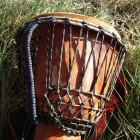I couple of winters ago I spent some time on the coast of southern Mexico in the state of Oaxaca, and discovered a troupe of young Mexicans playing a high level of West African music. In the hot humid climate the leader’s djembe rang out sharp and clear. How could he keep the skin so tight?
It was mylar, the plastic material you find often on doumbek heads, on floor toms from a drum kit, or on surdos used by samba and batucada bands. These ingenious folks had discovered a method I’d never seen before to maintain the tone of a djembe in all kinds of weather.
Back home on the “Wet Coast” of BC, my partner’s djembe was perched high on shelf in a warm room, and when I took it down to play one day, I awoke to the drummer’s nightmare: a split skin.
Reheading a djembe takes hours of hard, careful work, and it usually means acquiring and dealing with a good quality goat skin or calf skin: soaking, mounting, stretching, tightening, drying, tightening again. Calf is thicker and sturdier so offers a partial solution to the frequent turnover of your drum head. But now my eyes were open to a new possibility: mylar.

I had saved some discarded heads from the surdo drums I was playing with a local samba band. Voila, mylar for the deheaded djembe!
The material, while thin as a goat skin, is less pliable. To fold it over the bottom ring, so the fold would be sandwiched under the top ring, I had to fold little by little and tape the folds in place. With that done I could mount the head on the drum shell and apply the top ring over the folds. The top ring already had its rope knots in place from the previous head.
One of the trickier parts of placing a new head on a djembe is to keep it even and level as you tighten down all around the drum. I used a bungee to help steady the head on one side while starting to lace the verticals on the other side. Note the loop and free cord that I will tie together temporarily before I go around the drum pulling each vertical tight by hand.
Now that the rings are firmly secured by the verticals, the tape can come off the folds, and the head is approaching full stretch.

Having gone around a few times tightening verticals by hand, it’s time to bring some leverage into play. A stout dunun stick will do the trick. Insert behind the cord, anchor the bottom end under the lower ring, and pull down from the top end. If there’s too much slack, just twirl the stick through another turn or two of the cord before pulling down. This process will also require going around the drum a few times, before you risk breaking the stick. (You could use a length of iron pipe, or a hammer handle, instead). Each time around, you’ll retie that original knot from the hanging loop; and after the final round, give it a more permanent knot to secure before starting the horizontal Mali weave.
Once the verticals are tight, you can trim off the excess material from the folded skin. An exacto knife works perfectly to cut close around the ring and not leave ragged edges to damage your hands when playing. Note the blade is pointing out, to avoid slips and nicks of the blade into the delicate skin. The finished product is ready to go, no drying necessary, and the sound will carry sharp and clear no matter whether on a tropical beach or a northern rainforest. You might even say this kind of head is vegan-friendly, not to mention gluten-free!
Happy drumming…
More tips on How to Tighten and Tune Your Djembe Head
Free video lesson and diagram of Mali weave tightening knots (horizontal)











